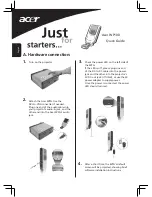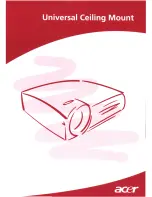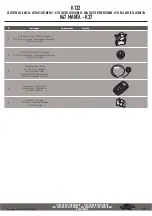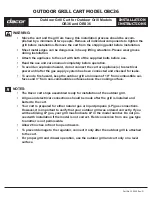
Operation of Trailer Valet
Never use Trailer Valet if the mounting clamps are loose or you are missing the stow pin.
Unhitching:
Lower the Trailer Valet into the vertical position, drop the stow pin in place and secure that with the
cotter pin.
Take the necessary precautions against uncontrolled trailer movement by locking the Trailer Valet brake
and placing tire blocks accordingly. Loosen/unlock the hitching mechanism and turn the jack crank
handle (part #3) to raise the trailer up off the hitch ball. Some hitching mechanisms can become stuck to
the ball, slightly rocking the trailer will loosen the connection, freeing the trailer. Remember to also
disconnect any towing safety chains and brake/turn signal wire harness or any other connections. Once
clear of the ball move the vehicle and lower the jack to its lowest height for the most stable and secure
use of the Trailer Valet.
Driving the Trailer Valet with the jack extended will cause excessive wear on
the jack and possibly result in injury, and/or property damage. Always lower the jack to its lowest
height before driving the Trailer Valet.
You are now free to drive the Trailer Valet.
Use of the Trailer Valet Safety Brake:
Never use the Trailer Valet on trailers which exceed the designed specifications listed in this manual.
Doing so can damage your Trailer Valet, result in injury, and/or property damage. Your Trailer Valet is
equipped with a safety brake to stop the motion of your trailer. If at any time you feel like you are going
to lose control or become fatigued, stop cranking the drive handle and engage the brake. If you ever
leave the area, place and secure tire blocks in case someone tampers with the brake handle.
The Trailer Valet brake is integrated into the steering handle allowing you to both propel and steer the
Trailer Valet while always having a hand on the brake for instant application.
To apply the brake, simply drop the steering handle with one smooth motion. This will lock the brake.
The Trailer Valet brake is
not intended to regularly stop your trailer if it is in motion
. Over time this can
cause excessive wear/damage and is considered misuse of the brake.
Parking your unhitched trailer:
When parking your trailer while unhitched, as you would with a standard jack, always place tire blocks
under the axel tires to prevent accidental movement in case the Trailer Valet brake is mistakenly
released. On slopes of any degree the trailer tires should be allowed to rest against the wheel blocks;
this is the most secure way to park your trailer when not hitched.
Failure to follow these basic guidelines may result in damage and/or injuries to persons and property
and is not the responsibility of the manufacturer.
Driving and Maneuvering the Trailer Valet:
Your Trailer Valet is equipped with both a high and low gear. The High-gear is recommended for use on
relativity flat surfaces. The Low-gear is recommended for use on slopes where the operator needs more
power to go uphill or more control going downhill. We recommend that all users start in the Low-gear
setting to get a feel for safely controlling the trailer. Operator’s good judgment is important for safe
operation.
Page 5


























